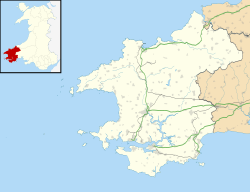RAF Angle
| RAF Angle HMS Goldcrest | |||||||||||
|---|---|---|---|---|---|---|---|---|---|---|---|
| Angle, Pembrokeshire in Wales | |||||||||||
| Coordinates | 51°40′28″N 005°05′54″W / 51.67444°N 5.09833°W | ||||||||||
| Type | Royal Air Force station RAF Forward Airfield 1941-43 | ||||||||||
| Code | AE[1] | ||||||||||
| Site information | |||||||||||
| Owner | Air Ministry Admiralty | ||||||||||
| Operator | Royal Air Force Royal Navy | ||||||||||
| Controlled by | RAF Fighter Command 1941-43 * No. 10 Group RAF RAF Coastal Command 1943- * No. 19 Group RAF Fleet Air Arm 1943 | ||||||||||
| Site history | |||||||||||
| Built | 1941 | ||||||||||
| In use | December 1941-1945 | ||||||||||
| Battles/wars | European theatre of World War II | ||||||||||
| Airfield information | |||||||||||
| Elevation | 56 metres (184 ft)[1] AMSL | ||||||||||
| |||||||||||
Royal Air Force Angle, or RAF Angle, is a former Royal Air Force station located on the Angle Peninsula Coast, 8 miles (13 km) west of Pembroke, Pembrokeshire, Wales. It was operational from 1 December 1941 to the 1950s, having been used by both the Royal Air Force (RAF) and the Royal Navy.
History
It was initially used by No. 32 Squadron RAF flying the Hawker Hurricane I. In November 1941 they were replaced by 615 Squadron, and the Hurricane IIC. Several Squadrons followed: 312 (Czechoslovak) Squadron flew the Supermarine Spitfire VB and 263 Squadron with the Westland Whirlwind.[2]
Next No. 152 Squadron RAF, No. 412 Squadron RCAF and No. 421 Squadron RCAF squadrons occupied the base, flying the Spitfire VB.[2]
During May 1943 794 Naval Air Squadron were posted here conducting target towing and the control of the airfield was transferred to the Royal Navy[3] with the site being renamed RNAS Angle (HMS Goldcrest).[4] However in September 1943 the Royal Navy moved from RNAS Angle to the RNAS Dale, and the RAF swapped sites in the other direction with the Coastal Command Development Unit moving in.[3]
The airfield was used as the base for trials of the prototype Highball bouncing bomb on 6 October 1943 using a tunnel at Maenclochog as a target. Highball was a spherical design with dimples by Barnes Wallis and were dropped by de Havilland Mosquito aircraft.[5]
Other units based at Angle were:
- No. 1 (Coastal) Engine Control Demonstration Unit (April 1944 - June 1944)[6] became the Engine Control Instructional Flight (June 1944 - January 1945)[7]
- Coastal Command Development Unit RAF (September 1943 - January 1945)[8]
Between 1945 and the 1950s Angle was used as a Relief Landing Ground for Fleet Air Arm aircraft based at RNAS Brawdy.[4]
Posted squadrons
| Squadron | Aircraft | Variant | From | To | To | Notes |
|---|---|---|---|---|---|---|
| No. 32 Squadron RAF | Hawker Hurricane | I/IIB | 1 June 1941 | 27 November 1941 | RAF Manston | [9] |
| No. 152 Squadron RAF | Supermarine Spitfire | VB | 16 August 1942 | 27 September 1942 | RAF Collyweston | [10] |
| No. 254 Squadron RAF | [4] | |||||
| No. 263 Squadron RAF | Westland Whirlwind | I | 18 April 1942 | 15 August 1942 | RAF Colerne | Detachment at RAF Portreath.[11] |
| No. 312 (Czechoslovak) Squadron RAF | Spitfire | IIB/VB | 24 January 1942 | 18 April 1942 | RAF Fairwood Common | Detachment at RAF Fairwood Common.[12] |
| No. 412 Squadron RCAF | Spitfire | VB | 29 January 1943 | 8 February 1943 | RAF Fairwood Common | [13] |
| No. 421 Squadron RCAF | Spitfire | VB | 26 October 1942 14 November 1942 4 December 1942 |
1 November 1942 30 November 1942 29 January 1943 |
RAF Zeals RAF Charmy Down RAF Kenley |
[14] |
| No. 615 Squadron RAF | Hurricane | IIB/IIC | 27 November 1941 | 23 January 1942 | RAF Fairwood Common | [15] |
| 759 Naval Air Squadron | [4] | |||||
| 794 Naval Air Squadron | May 1943 | September 1943 | RNAS Dale | Target Towing.[3] |
Current use
The site has reverted to farming[4] and only a few huts and the perimeter track are left.[3]
See also
References
Citations
- ^ a b Falconer 2012, p. 35.
- ^ a b Notes from Pembroke County War Memorial site
- ^ a b c d "Angle Airfield, Angle". National Monuments Record of Wales. Retrieved 13 June 2013.
- ^ a b c d e "Angle". Airfields of Britain Conservation Trust. Retrieved 13 June 2013.
- ^ Photo and notes from Maenclochog Tunnel
- ^ Sturtivant, Hamlin & Halley 1997, p. 94.
- ^ Sturtivant, Hamlin & Halley 1997, p. 112.
- ^ Sturtivant, Hamlin & Halley 1997, p. 93.
- ^ Jefford 2001, p. 35.
- ^ Jefford 2001, p. 62.
- ^ Jefford 2001, p. 80.
- ^ Jefford 2001, p. 86.
- ^ Jefford 2001, p. 90.
- ^ Jefford 2001, p. 91.
- ^ Jefford 2001, p. 100.
Bibliography
- Falconer, J (2012). RAF Airfields of World War 2. UK: Ian Allan Publishing. ISBN 978-1-85780-349-5.
- Jefford, C.G. RAF Squadrons, a Comprehensive Record of the Movement and Equipment of all RAF Squadrons and their Antecedents since 1912. Shrewsbury, Shropshire, UK: Airlife Publishing, 2001. ISBN 1-84037-141-2.
- Sturtivant, R; Hamlin, J; Halley, J (1997). Royal Air Force flying training and support units. UK: Air-Britain (Historians). ISBN 0-85130-252-1.


